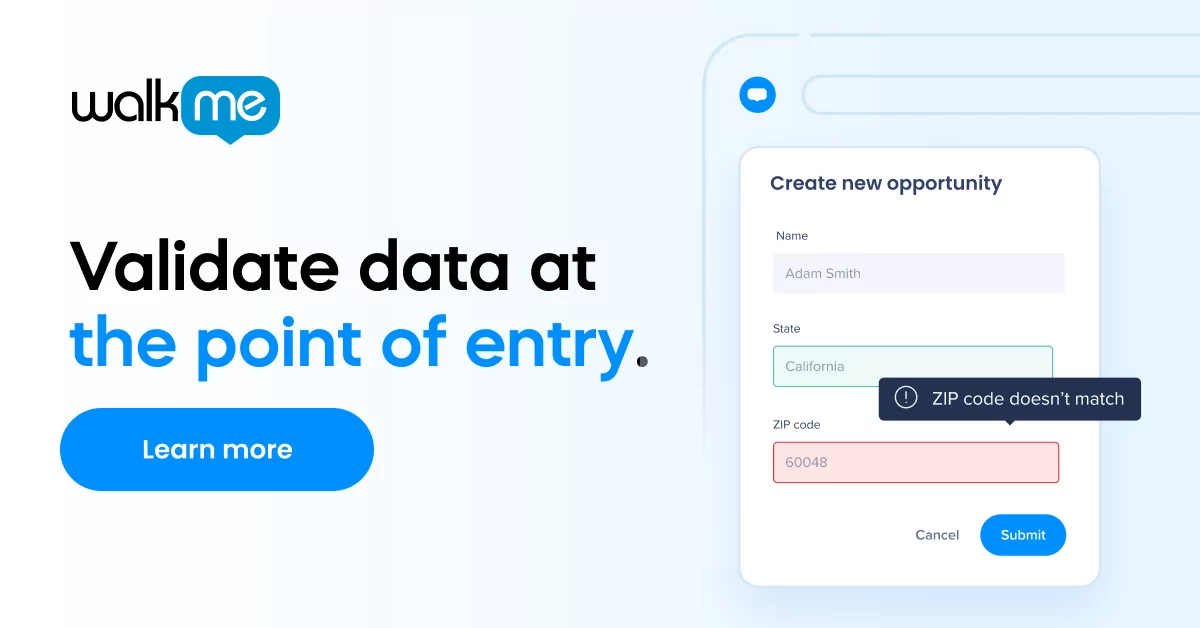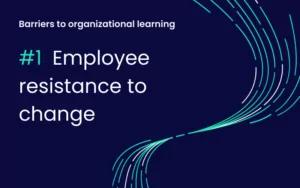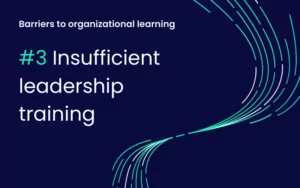As a training and development professional, leading enterprise-wide learning is one of your most important responsibilities. But finding the right approach is no easy task. Anyone with experience doing so can probably recall several major barriers to organizational learning.
But obstacles don’t have to turn into failures. We learned this lesson from Thomas Edison.
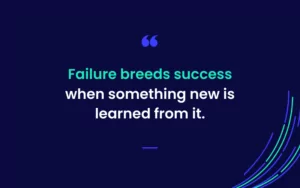
It took more than 150 failed attempts before Edison succeeded to make the first working light bulb. From all of those defeats, he mastered the filament technique that would eventually dominate lighting technology. But Edison never saw his initial pursuits as failures. Instead, he stated that he found over 150 ways not to make a light bulb.
Edison had the wisdom to understand that failure breeds success when something new is learned from it. We can apply the same logic to identifying barriers to organizational learning. If we know which potential hurdles can impede educational efforts, we can learn to overcome them to create real organizational transformation.
7 barriers to organizational learning
#1 – Employee resistance to change
Resistance to change is a common barrier to organizational learning. People who have been at their jobs for a long time and are set in their ways often don’t want to learn new processes.
But resistance to change doesn’t only occur among the most tenured of employees. No, this kind of mentality can arise among anyone who doesn’t want to step away from the comfort of familiar processes and systems.
But for an organization to advance, change must be ongoing. As an organization adapts to dynamic markets, internal processes, knowledge, and use of technology will need to keep up.
To prevent resistance to change, explain to your employees why the change is necessary and how it will benefit them. Be creative and try to understand on a deeper level what is getting under employees’ skin.
Try these change management exercises which will create a non-threatening environment to speak about resistance and fear of change. Managers and learning and development professionals need a variety of tools at their disposal to encourage organizational learning – a one-size-fits-all approach is limiting.
#2 – Ignoring the elephant in the room
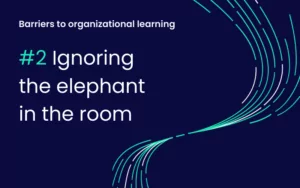
What elephant are we referring to? That of the unpleasant aspects of organizational learning. These sensitive topics will vary depending on the change you implement, but they could be a new process, eliminating a technology platform your team is used to, or disruption to workflow.
It’s important to directly communicate the potential pitfalls and challenges that your employees might encounter from the outset. Ignoring these concerns will erode trust and potentially create more resistance to proposed changes. Transparency and direct communication will make it easier in the future to institute change and new learning requirements for your organization.
Once you have identified barriers to organizational learning, you can find a solution. But, if left unaddressed, they will fester and get worse.
#3 – Lack of leadership training
Leadership development is critical to organizational learning.
Communication, change management, and support skills required to guide organizational learning must be taught and encouraged.
Inadequate leadership training leads to poorly run teams and chaos during periods of change. If a supervisor or manager isn’t engaged with a new process or training they are supposed to lead, employees will most likely tune out. If organizational learning is not prioritized from the top-bottom, it will not succeed, thus undermining the organization as a whole.
On the other hand, leaders who are equipped to guide learning efforts will boost the morale and confidence of their teams.
Continuous training and development is the key to ensuring your managers can guide change and learning efforts effectively.
#4 – Disregard of team success
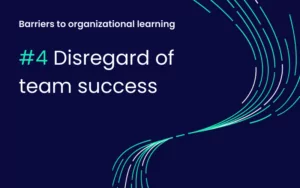
Sometimes, it’s difficult to see how organizational learning programs fit in with an individual’s personal goals.
Learning often takes time and effort away from employees’ day-to-day tasks. When an organization prioritizes this investment in learning, but the employee does not, it is difficult to encourage engagement.
If your employee is focused on their individual achievements, then frame organizational learning as part of their employee development. Teaching skills beyond an employee’s existing job description can be a catalyst for their own career growth.
Their individual success will ultimately lead to team success and managers should also emphasize team achievements through positive reinforcements.
#5 – No motivation for growth
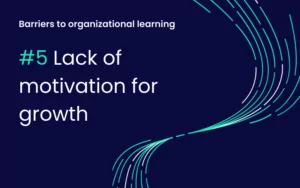
Deloitte’s 2019 Global Human Capital Trends survey listed learning and development as the top-ranked challenge for managers.
The excuse “That’s not in my job description” represents one of the most challenging barriers to organizational learning. Similar to the effects of resistance to change, employees who are not motivated for growth will not seek out opportunities provided by the organizations.
Not all organizational learning programs will be mandatory, even though they might still add value to an employee. This means the employee’s personal motivation to learn and grow will determine whether or not they participate.
To overcome this barrier, try motivating your employees by explaining the future benefits of the learning initiative. You might also consider implementing a system for rewarding employees as they make progress.
#6 – Short-term focus
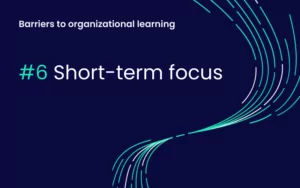
In business, it’s often easy to focus on stop gaps to solve short-term problems without looking at the big picture. If an employee’s job is not focused on the long-term vision of the company, it’s easy to get caught up in short-term goals that do not include learning skills for the long-term benefit.
To solve this issue, encourage employees and managers to dedicate time for long-term goals and offer learning opportunities to fill this time.
#7 – Complexity
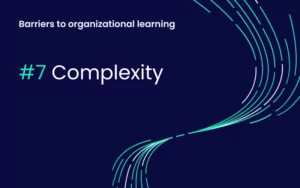
In the hyper-connected and always-busy world we live in today, complexity overwhelms the modern employee. In the digital workplace, we’re often multi-tasking across multiple systems and platforms. The result is what we call digital friction.
Picture the experience of learning a new software system. An employee may be taught in a webinar, given a link to a knowledge base online and the login for actually using the system. Even though all the information is there, when it comes time to implement their new skills, they may need to bounce between three or more tabs to successfully reach their objective. That’s complex!
To overcome this barrier to organizational learning, simplify your training programs and materials to deliver only the information they need in the simplest possible format. This will allow your trainees to absorb the information and put it to use faster.
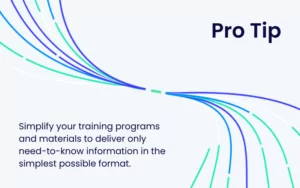
Organizational learning from afar
The world has rapidly changed since COVID-19. It ushered in a new era of remote in which employees continue working in remote and hybrid environments.
A dispersed workforce, however, doesn’t mean a stop to organizational learning. It simply requires technology to play a greater role to facilitate onboarding and training, employee development, and support.
Technology is the key to improve organizational learning
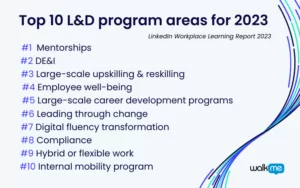
In LinkedIn’s 2023 Workplace Learning Report, digital fluency transformation is listed in 7th place for the top 10 L&D program areas for 2023. In addition, role-specific digital upskilling and digital transformation are listed in 2nd place for the top three training topics for managers in 2023.
A digital adoption platform (DAP) is a way to ensure that employees continue their organizational learning regardless of physical location. New software is easier to understand as DAP uses in-app guidance to lead users through business processes and workflows. Additionally, when DAP is enabled, tedious processes can be automated, thus reducing user-friction and giving employees more time to focus on immediate or urgent tasks.
Managers and DAP admins have visibility into how employees are using new or existing software which can pinpoint areas of confusion. Once identified, workflows can be adjusted or helpful content can guide users through work processes.
Futurum Research recently released “An Enterprise Guide to Digital Adoption“. It demonstrates how utilizing a DAP can make the difference between companies who drown in a digital ocean of applications, and those who can build a yacht for smooth sailing.
A digital adoption platform is a tool that empowers organizational learning and can be used by employees and managers – anytime, anywhere.
